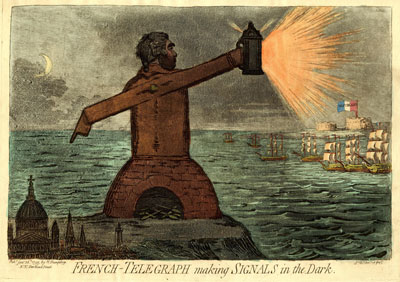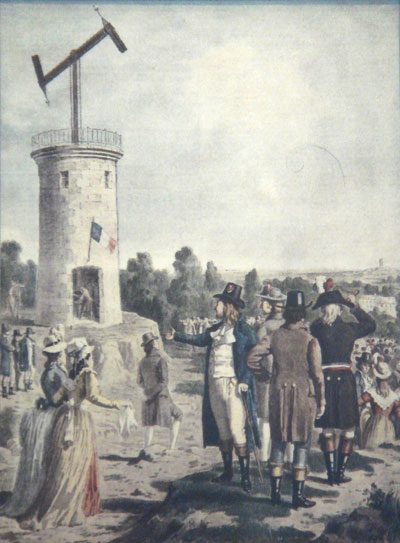French-Telegraph Making Signals in the Dark
As far back as December 1792, in The Dagger Scene, or the Plot Discover'd, Gillray had suggested that Fox's well-known sympathy for, and defense of, France was essentially treasonous, that he and Richard Brinsley Sheridan were involved in a plot to provide daggers to would-be English revolutionaries. Since then, Gillray had been endlessly inventive in questioning Fox's loyalty. In A Democrat, or Reason and Philosophy, he had portrayed Fox as a sans-culotte with his hands still bloody fron the execution of the French King. In Dumourier Dining in State at St James's, he had shown Fox wearing the bonnet rouge of a revolutionary and serving up Prime Minister William Pitt's head on a platter to the French Commandant Charles Francois Dumouriez. And in Britannia between Scylla and Charybdis, he had included Fox as one of the French "Dogs of Scylla" who would (if they could) drive Britannia to founder on the "Rock of Democracy."

© Trustees of the British Museum
So it is not wholly surprising that Gillray would find yet another way of castigating Fox and associating him with France when the newspapers began to be filled with discussions of a new French invention, the "telegraph." And it would have been particularly timely with the recent treason trials of John Thelwall, Thomas Hardy, and Horne Tooke, and with the suspension of habeas corpus.
Claude Chappe had first demonstrated his semaphore system of towers and cross-arms to convey textual infornmation in 1792. But already in September 1794, according to the European Magazine, the leadership of the Committee of Public Safety was able to announce that
by a new Telegrapbic Machine, invented by Citizen CHAPELLE (sic), the news of the capture of Quesnoy had been received by the Committee in one hour. By this invention, which spoke a particular language, and could express every thing, even proper names, thoughts could be transmitted from one end of the Republic to the other, with a speed that mocked all previous calculation.

Chappe's Telegraphe
[19th Century]
Wikimedia Commons
Photographed in Musee des Arts et Metiers
In the same month, the London St James Chronicle Or British Evening Post, (September 27, 1794,Pg. 2) carried a detailed "Description of the Telegraphe" from a Gentleman who was at Paris within this month and who saw its operations." And if he had missed that, Gillray could have seen the following notice for Astley's
Astley who is always employed in the production of something new, brings out this evening an exhibition of the much talked of, and ingenious Machine, called the TELEGRAPHE, at the Lyceum, in the Strand.
London Times, September 19, 1794,Pg. 3
Taking advantage of the current concern with treasonous activities and the new French invention then, Gillray portrays Fox as a human telegraph whose arms hold a lantern to direct a waiting French fleet in the English Channel where best to attack. At his feet, we can see a piles of daggers reminding us of Fox's earlier purported plot.
Sources and Reading
- Commentary from the British Museum on French-Telegraph Making Signals in the Dark.
- Draper Hill, The Satirical Etchings of James Gillray, 1976, #34
- "Optical telegraph," Wikipedia
- "Claude Chappe," Wikipedia
- "Charles James Fox," Wikipedia
- "Habeas Corpus Suspension Act 1794," Wikipedia
- Thomas Wright and R.H. Evans, Historical and Descriptive Account of the Caricatures of James Gillray #111.
- Thomas Wright and Joseph Grego, The Works of James Gillray, the Caricaturist; With the History of His Life and Times, p. 181-2.
Comments & Corrections
NOTE: Comments and/or corrections are always appreciated. To make that easier, I have included a form below that you can use. I promise never to share any of the info provided without your express permission.